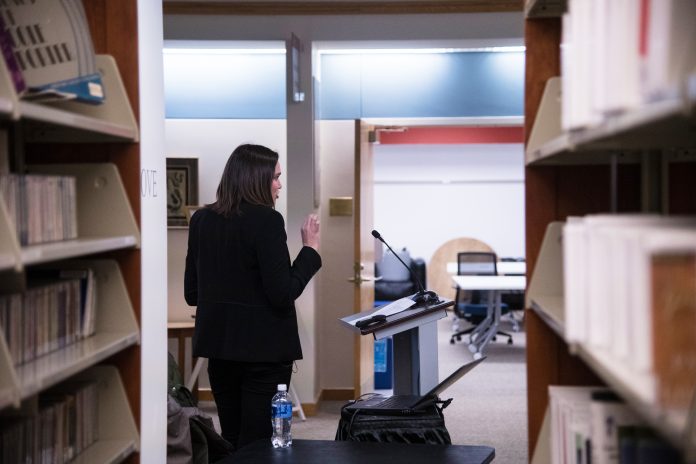Muhlenberg’s History Lecture Series, “A Century of Struggle: Women’s Rights Before and After Suffrage,” began on Thursday, Jan. 23 with Dr. Allison Lange’s presentation: Images and the Fight for Women’s Voting Rights in the United States. Lining up with the centennial celebration, the focus is on Women’s Suffrage and the rights and movements that have followed over the past 100 years. Last year, the History Club went to their faculty advisor with the idea of a program diving into this subject, making the speaker series a student-directed initiative. Dr. Cathy Ouellette, head of the history department, and her colleague, Dr. Jacqueline Antonovich, have spearheaded this series.
“We want to complicate some of the narratives coming out this year for the centennial,” said Antonovich. Ouellette added that this will help us “more accurately remember the past.”
The question they wish to pose is how we can celebrate this movement whilst recognizing its faults, and how that solution gets used moving forward. A key critique is how the leaders of the suffrage movement left out women of color. The popular women’s suffrage narrative is white and Eurocentric.
“We want to complicate some of the narratives coming out of this year for the centennial.”
Dr. Allison Lange, Assistant Professor of History at Wentworth Institute of Technology, focuses on visual debates about suffrage, saying “Images still influence the way we think about gender, politics and power in the 21st century.”
The images Lange analyzed were a mixture of portraits and political cartoons and illustrations. Many of these images showed women as having masculine features, outlandish outfits and towering hair, and abandoning their children. One particular image, by Philip Dawe, showed a woman of color looking intrigued by others’ actions. Lange explained that images such as these demonstrated a concern that, “If women win rights, gender hierarchy will shift, as well as racial hierarchy.”
Even a century later, the same fears were played upon to shift public thought and opinion. When women started to campaign for more equality, backlash followed. They were shown straying from traditional roles, such as domestic tasks. One image showed a man holding a baby, which Lange joked was “The 19th century version of the apocalypse.”
Students shared what they took away from the presentation. Jennifer Sanchez ‘20 said “The talk was interesting because it discussed parts of Susan B. Anthony and Elizabeth Cady Stanton’s lives that are not often mentioned in our K-12 education. One such thing was how Susan B. Anthony went to great lengths to make her image known to us now, 100 years after the 19th Amendment was passed.”
When asked to think of a suffragist, the answer usually given is Anthony. As mentioned above, that was driven by Anthony’s own motivation. She wanted her portrait to be distributed and to be remembered after her time.
Lange emphasized the political nature of images, explaining that today, social media such as instagram is used to cultivate a public image.
“When it comes to the women’s movement, I think most of us imagine marches and protests, yet very few of us think about photographs and political cartoons; but, these were the ways in which many people’s opinions were swayed, both for and against the movement.”
When the 20th century rolled around, the leading suffragists of the time were working to turn their public image into something more favorable, showing women wanting the vote as soft and motherly, as well as fashionable. While still getting jabbed at through unflattering political cartoons, women like Anthony and Stanton had a very particular vision that they wanted to express. Strategically, they had to cut out some prominent people from the time in order to promote an image that could be adopted by the general public. Anthony realized she had to play to her audience.
In order to be successful, the suffragists left out women of color and men who supported the cause. African-American women did participate in marches, but it is much less well-documented than the participation of white women. Thus, important narratives have been erased from history. One hundred years later, the fight for rights has not ended. It may have started with the vote, but women today are still fighting for bodily integrity, which will be covered later in this speaker series.
Hallie Hoffman, ‘22 commented, “It was amazing to hear about the ways in which the women’s suffrage movement was influenced, opposed and eventually won through the use of images. When it comes to the women’s movement, I think most of us imagine marches and protests, yet very few of us think about photographs and political cartoons … these were the ways in which many people’s opinions were swayed, both for and against the movement. I couldn’t believe some of the incredibly offensive and stereotypical views that were widely shared through these images. I think it’s really important for us as students to learn about these sides of history that we don’t often hear about.”






















